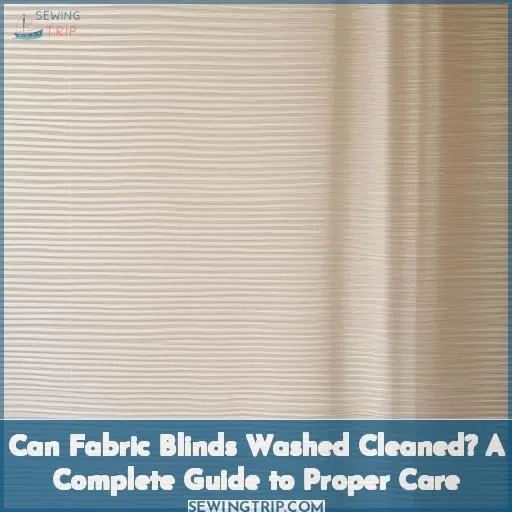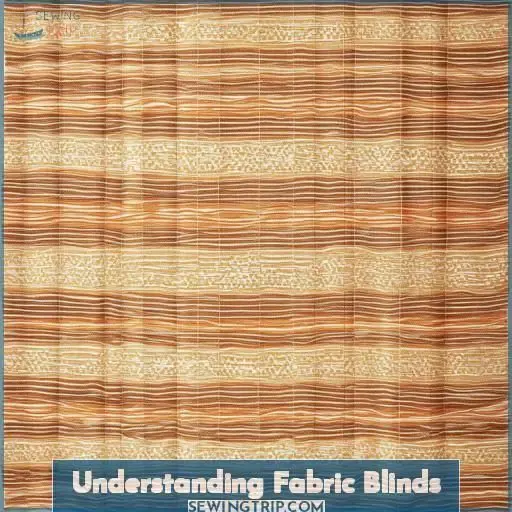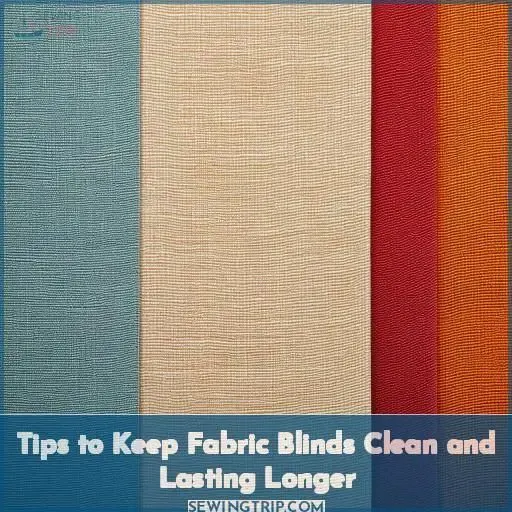This site is supported by our readers. We may earn a commission, at no cost to you, if you purchase through links.
 Yes, fabric blinds can certainly be washed and cleaned!
Yes, fabric blinds can certainly be washed and cleaned!
With a few simple steps, you’ll keep them looking fresh and fabulous.
Start by giving them a gentle vacuum with the brush attachment to remove any dust bunnies.
For light cleaning, spot clean with a mild detergent and warm water solution.
But for a deeper clean, you’ll want to remove the blinds and soak them in soapy water before scrubbing gently.
Just be sure to check the manufacturer’s care instructions first.
Maintaining regular upkeep will guarantee your fabric blinds retain their showroom shine.
Want to learn the proper techniques for deep cleaning fabric blinds without any fuss? Let’s delve into the details.
Table Of Contents
Key Takeaways
- Whether they’re pleated, Roman, roller, or vertical, fabric blinds need a little TLC to stay looking sharp. Just like a good friend, give them some love with regular dusting, spot cleaning, and deep soaks when they’re really feeling grungy.
- Stains happen – spills, splatters, who knows what else? Don’t let them stick around! Blot those suckers right away with a mild detergent solution. It’s like nipping trouble in the bud before it has a chance to bloom into an eyesore.
- Ever had a favorite shirt you couldn’t bear to part with, even when it was looking a bit…well-loved? Fabric blinds are no different. Treat them right with manufacturer-approved cleaning methods, and those beauties will be serving looks for years to come.
- When in doubt, don’t be afraid to call in reinforcements! Professional cleaners have all the tricks up their sleeves to restore those fabric blinds to their former glory. It’s like giving your home an ultra-fresh makeover without the hassle.
Can Fabric Blinds Washed Cleaned?
Yes, fabric blinds can be washed and cleaned. Regular maintenance like vacuuming, dusting, and spot cleaning with mild detergent and warm water can help keep fabric blinds clean. For a deeper clean, some fabric blinds can be soaked and scr믭 in a bathtub with mild soap and warm water.
Understanding Fabric Blinds

Fabric blinds come in various types, such as pleated, vertical, Roman, roller, and panel, each with unique characteristics that determine their suitability for specific spaces and cleaning requirements. Understanding the differences between these blinds is essential for proper maintenance and cleaning to maintain their longevity and desirable appearance.
Types of Fabric Blinds
You’ve got several options in regard to fabric blinds. There are 1) pleated shades, 2) vertical blinds, 3) Roman shades, and 4) roller shades. Each type varies in material, durability, cleaning needs, and cost. Understanding these factors upfront will help you choose wisely and keep your blinds looking fresh for years.
Characteristics of Each Type
You’ll encounter different fabric blind varieties like pleated, Roman, roller, vertical, and panel styles. Each boasts distinct characteristics regarding fabric textures, light filtration, insulation properties, and aesthetic appeal. Here’s a handy comparison:
| Type | Texture | Light Control | Insulation | Look |
|---|---|---|---|---|
| Pleated | Smooth | Filter light | Moderate | Clean lines |
| Roman | Structured | Adjust opacity | Good | Layered folds |
| Roller | Plain | Blackout | Basic | Minimalist |
| Vertical | Sleek | Screen light | Fair | Contemporary |
| Panel | Patterned | Sheer | Poor | Decorative |
Understanding these nuances aids smarter cleaning and maintenance choices.
Regular Maintenance
For regular maintenance, vacuum fabric blinds with a brush attachment to remove dust and debris, then dust with a feather duster, microfiber cloth, or DIY duster. Spot clean stains promptly using a mild detergent solution and warm water, gently blotting the affected area instead of rubbing to avoid damaging the fabric.
Vacuuming With Brush Attachment
Regular vacuuming is essential for fabric blind maintenance. Use your vacuum’s upholstery brush attachment and:
- Hold blinds steady at the bottom
- Gently vacuum each slat
- Vacuum the reverse side if one piece
- Clean window sills and inside windows
Go slowly and be thorough – vacuuming removes surface dirt, dust, and debris that can damage fabric over time. For specific cleaning examples and additional tips, keep reading!
Dusting With Feather Duster, Cloth, or DIY Duster
You’ll want to dust your fabric blinds regularly with a feather duster, microfiber cloth, or DIY duster. A feather duster gently removes surface dust without damaging fabrics. Microfiber cloths attract and trap dust particles. For DIY dusters, use clean socks or cotton rags secured over a bendable rod or dowel.
Spot Cleaning With Mild Detergent and Warm Water
You’ll also want to spot clean any stains right away using a mild detergent and warm water. Always test the detergent on an inconspicuous area first to guarantee it won’t discolor the fabric. Gently blot the stain, never rub, and be sure to rinse thoroughly with clean water. Spot cleaning regularly helps prevent dirt and grime buildup.
Choosing Appropriate Cleaning Solution
You’ll want to choose a cleaning solution suitable for fabric blinds. Mild dish soap, laundry detergent, or vinegar work well. Avoid harsh chemicals. For vertical blinds, test commercial cleaners in an inconspicuous area first. Steam cleaning is also an option for deep cleaning fabric blinds. Always test solutions before applying to prevent damage.
Blotting (not Rubbing) to Clean
When spot cleaning, always blot the fabric blinds; never rub vigorously. Rubbing can grind stains deeper into the fibers. Gently blot with a clean cloth dampened with a mild detergent or natural cleanser like vinegar. For tougher stains, try a bleach solution or fabric spray foam cleaner, blotting gently. Finish by blotting with a dry DIY duster or cloth.
Spot Cleaning
For spot cleaning fabric blinds, use a mild detergent mixed with warm water, blotting the area gently; avoid harsh chemicals, and consider using a diluted white vinegar solution as a natural cleanser. Test any cleaning solution in an inconspicuous area first to make certain it won’t damage or discolor the fabric.
Using Mild Detergent and Warm Water
For spot cleaning, use a mild detergent and warm water. Here are a few tips:
- Choose a gentle, dye-free detergent
- Use lukewarm water to avoid setting stains
- Gently blot – don’t rub – to lift dirt
Spot cleaning regularly extends the life of your fabric blinds. It’s a simple process that delivers big results, keeping your blinds looking fresh and clean. Just a little care goes a long way!
Testing Cleaning Solution in Inconspicuous Area
Before using any cleaning solution on your fabric blinds, it’s vital to test it on an inconspicuous area first. This pre-cleaning preparation confirms the solution is safe and won’t cause discoloration or damage. Simply dab a small amount onto a hidden corner and let it dry. If no issues arise, you can proceed with confidence, avoiding potential mishaps.
| Solution | Location | Result |
|---|---|---|
| Mild soap | Back corner | No damage |
| Vinegar | Under slat | Safe |
| Bleach | Test first | Risky |
Avoiding Harsh Chemicals
After testing the cleaning solution on an inconspicuous area, you’ll want to avoid harsh chemicals that could damage the fabric. Opt for gentler options like mild detergent or soap. Delicate blinds may require professional cleaning, but for most, you can safely spot clean without risking discoloration or wear from harsh chemicals.
Using Diluted White Vinegar as Natural Cleanser
You can use a diluted white vinegar solution as a natural cleaner for spot cleaning fabric blinds. First, test for colorfastness in an inconspicuous area. Then:
- Mix equal parts vinegar and water
- Dip a microfiber cloth in the vinegar solution
- Blot the stained area gently
- Rinse with a damp cloth
- Allow to air dry completely
Vinegar is an affordable, gentle option that helps remove stains while being kind to delicate fabrics.
Deep Cleaning
Now that you’ve mastered spot-cleaning, it’s time to take your fabric blind maintenance to the next level with deep cleaning. Whether your blinds are made of delicate or expensive materials, regular deep cleaning is essential to keep them looking their best. Here’s how to tackle this task like a pro:
- Remove the blinds from the window and soak them in a tub of warm, soapy water for a few hours. This allows deep-set grime to loosen up.
- Gently scrub each slat with a soft-bristled brush to dislodge any remaining dirt or stains.
- Rinse thoroughly to remove all soap residue, then hang or lay flat to air dry completely.
For high-end blinds, consider professional cleaning services to guarantee proper care and maintain their pristine condition.
Specific Examples
Pleated shades demand careful handling: vacuum them, then use a fabric spray foam cleaner, gently wiping with the fabric’s grain.
Blot any spots and wait for complete dryness before rehanging.
Roman shades require verifying machine-washability; if not, dust and vacuum, remove dowels and strings, hand-wash gently, hang to air-dry, smooth any wrinkles, restring, and replace dowels.
For delicate or high-end blinds, professional cleaning safeguards their longevity.
Consistently follow manufacturer care instructions, spot-cleaning promptly to prevent staining.
With diligent, appropriate cleaning, your fabric blinds will retain their fresh, inviting appearance.
How Do You Clean Fabric Blinds in a Bathtub?
For a deep clean, you’ll need to remove the fabric blinds from the headrail and soak them in a bathtub filled with warm water and a mild detergent for 2-3 hours. After soaking, scrub the blinds gently with a soft-bristled brush, rinse thoroughly, and then hang them to air dry completely.
Removing Blinds From Headrail
You’ll need to remove the blinds from the headrail for thorough cleaning. Here are the steps:
- Unclip or unhook the blinds carefully from the headrail
- Lay them flat on a clean surface
- Avoid creasing or folding to prevent damage
- Check the manufacturer’s instructions for any specific guidance
- Removing the blinds allows for efficient, thorough cleaning
Filling Bathtub With Warm Water and Mild Detergent
After removing the fabric blinds, fill your bathtub with warm water, aiming for a temperature range between 80-100°F (27-38°C). Add a mild, gentle detergent—avoid harsh cleaners that could damage the fabric. For minor stains, use a small amount of detergent. For heavy soiling, increase the detergent slightly. Agitate the water to create suds for optimal soaking.
Soaking Blinds for 2-3 Hours
Once you’ve filled the bathtub with warm water and mild detergent, let the fabric blinds soak for 2-3 hours.
This soaking time allows the detergent to penetrate the fabric and loosen any stubborn dirt or grime.
Be sure to use a gentle, non-abrasive detergent to avoid damaging the blinds’ material.
During the soaking process, occasionally agitate the blinds to ensure even saturation.
Scrubbing Blinds With Soft-bristled Brush
After soaking, gently scrub the fabric blinds with a soft-bristled brush.
The bristles should be soft enough to avoid damaging the material.
Use a brush size and shape that fits the slats or folds.
Apply gentle pressure while scrubbing, taking care not to fray or stretch the fabric.
For hard-to-reach areas, consider using a small brush or old toothbrush as an alternative cleaning tool.
Rinsing Blinds Thoroughly
After scrubbing your fabric blinds, rinse them thoroughly to remove all soap residue. Use cool to lukewarm water, and:
- Rinse each slat individually while gently squeezing out soapy water
- Allow blinds to soak briefly in a clean rinse bath
- Repeat rinsing process until water runs clear
- Check that no soap bubbles remain on fabric
Thoroughly rinsing prevents soap buildup and guarantees your blinds look fresh and clean once dry.
Hanging Blinds to Dry
Once thoroughly rinsed, you’ll need to hang the blinds to dry. Consider using a shower rod or clothesline for more airflow. Avoid direct sunlight exposure, as it can cause fading. Drying time depends on fabric type, but typically takes 4-6 hours. For best results, skip fabric softener when washing fabric blinds.
Tips to Keep Fabric Blinds Clean and Lasting Longer
To keep your fabric blinds looking their best for years, you’ll need to regularly dust and vacuum them.
Spot clean any stains immediately before they set in.
Choose the appropriate cleaning methods and solutions based on the specific type of blinds you have.
Properly caring for and storing your blinds when not in use will also help extend their lifespan.
Regular Dusting and Vacuuming
You’ll want to dust and vacuum your fabric blinds regularly – aim for once a week. This prevents buildup and keeps them looking fresh. Use the brush attachment and go gently. Proper storage when not in use, shielding from sunlight, and tackling pet hair and odors promptly are also key for longevity.
Spot Cleaning Immediately
You’ll want to spot clean fabric blinds immediately to prevent stains from setting. Here are 3 tips:
- Blot spills quickly with a clean, dry cloth. Don’t rub, as this can spread the stain.
- Use a mild detergent or DIY solution of vinegar and water to gently clean the affected area.
- For tough stains, seek professional cleaning services to avoid damaging the fabric.
Prompt action and the right cleaning method can keep your blinds looking fresh.
Choosing Appropriate Cleaning Methods for Each Type of Blind
You’ll want to choose cleaning materials and methods suited for your specific blinds. For pleated shades, use a gentle fabric cleaner and wipe lightly. Vertical blinds often require soaking and scrubbing. Roller blinds demand light, dry dusting. Stay mindful of stain removal, mold prevention, and when deep cleaning or professional cleaning is necessary.
Maintaining Proper Care and Storage
Proper care and storage are essential for fabric blinds’ longevity. Choose storage solutions that protect against moisture, dust, and sunlight to prevent mildew or fading. Vacuum regularly to remove pet hair. When storing long-term, wrap them in breathable covers or hang them to avoid creasing. With these simple steps, you’ll keep your fabric blinds looking fresh for years.
Frequently Asked Questions (FAQs)
Can you wash fabric blinds in the washing machine?
Yes, you can wash fabric blinds in the washing machine. Take them down, shake off any loose dirt, and wash on a gentle cycle with cold water and mild detergent. Air dry completely before rehanging.
How do you clean fabric blinds in the bath?
To clean fabric blinds in the bath, submerge them in warm soapy water. Gently scrub with a soft brush or sponge. Rinse thoroughly, then hang or lay flat to air dry completely.
Can you wash fabric roller blinds?
Cleaning crushed curtains carefully requires rolling roller shades repeatedly. Rinse rolled rigs routinely, rotating rollers repeatedly, releasing restraints remarkably. Rehanging refreshed rigs restores revived radiance.
How to clean pleated fabric blinds?
Vacuum pleated blinds first with a brush attachment. Make a mild soap solution and wipe each pleat gently with a damp cloth. Use a clean, dry cloth to remove excess moisture and allow the blinds to fully air dry before closing.
How often should fabric blinds be cleaned?
Like dusting cobwebs from corners, fabric blinds thrive on regular attention. For ideal freshness, aim to clean them every 3-6 months, depending on sunlight exposure and indoor activity levels.
Can fabric blinds be machine washed safely?
You can machine wash most fabric blinds safely. However, check the manufacturer’s instructions first. Delicate blinds or those with decorative elements may require hand washing or professional cleaning.
What cleaning solutions are safe for fabric blinds?
You’re in luck! Mild detergents like dish soap or laundry detergent are perfect for cleaning fabric blinds safely. Avoid harsh chemicals that could damage or discolor the material.
How do you remove tough stains from fabric blinds?
To remove tough stains from fabric blinds, make a solution of warm water and mild detergent. Gently scrub the stain using a soft-bristled brush, then rinse thoroughly with clean water. Allow the blinds to air dry completely before rehancing.
Can fabric blinds be professionally cleaned and restored?
Ever wondered if those fabric blinds could be professionally cleaned? You bet! Professional cleaners use specialized techniques to restore their vibrant colors and like-new appearance. From deep cleaning to stain removal, they’ve got the expertise to make your blinds look fantastic again.
Conclusion
Just as Sisyphus’ eternal toil taught perseverance, maintaining your fabric blinds’ pristine allure requires diligent care. Following these guidelines for regular vacuuming, spot cleaning, and occasional deep cleaning – where you can wash fabric blinds – will keep them vibrant. Exercise caution with cleaning solutions, and always adhere to manufacturer instructions. With proper techniques, your blinds’ timeless elegance endures effortlessly.












